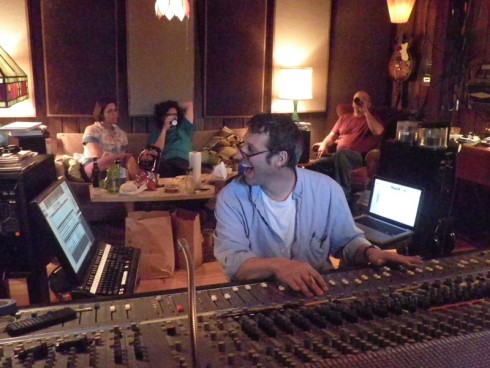On Recording – Pt. 1
Making an “album” is still what many people think of as the object of recording. It seems simple enough. You are a great musician. You have songs, and you have a microphone/recording device, which these days could be someone’s phone. You perform your songs into the device, upload and thanks for the Grammy. Right? Not so simple.
Why? Beyond the obvious answers (re: the need for relentless self-promotion, industry connections, actual skill…) there’s a deeper problem, which is that it’s really difficult to make a good recording. How many times have you seen a great band or singer perform, bought their record, and been disappointed by the smallness, the way in which it fails to surprise you? How many times have you been underwhelmed by the smallness, the way in which a recording falls into the obvious box of stale sounds and safe licks? What makes it so hard? At the risk of stretching, I’m going to reach for a concept made popular by the clearly-related-to-music-making field of quantum physics, called entanglement. Let me explain.
To put it simply, the theory of entanglement states that the act of observing something unavoidably alters the thing being observed. To begin with let’s take a look at the acrobatics that a soundwave has to perform before it gets to the ears of any listener. First, it has to be captured by the microphone, whose job it is to turn the air pressure of the wave into electricity. The type, size of and materials used to make a microphone (not to mention the quality of construction) will all impart a characteristic – a fingerprint – on the sound. Now we have an electrical signal which has to travel along a cable, or a wire, or perhaps across a circuit board, before it gets to the recording device. The length, width and materials used in this path will have an effect on the strength and purity of the signal. At some point, the microphone signal needs to be amplified, increased enough so that it will translate into something audible. Once again, the sound is altered. On it goes, through the recording device with its tape-record heads or analog-to-digital converters (now it’s data), eventually to a pair of speakers somewhere, where it is re-converted back into sound waves. When you think about it, it’s a wonder anything survives all these trials.
Of course, this is just the beginning of the story. Now the performer has to listen to this sound he or she has just sent tumbling through all these hoops and reconcile it with the way he/she thought it was supposed to sound. Especially where the voice is concerned, this can be very difficult for all but the most seasoned studio professionals. Layers of psychology come into play, most of which have to do with the way musicians and listeners alike deal with the huge conundrum sitting right at the core of the recording process – the difference between live music and recorded music.
Live music is, well, alive. It is an action being taken by a living being and observed in real-time by other living beings. Each instance of it is unique and unrepeatable. The amount of information being created each second is vast, the experience of it is unique to the time, place, and people involved. Each instance obliterates the previous one. It’s a one way journey the performer and listener undertake together.
Recorded music is dead. A butterfly in a glass case. Endlessly reviewable, always exactly the same. Finite. Unchanging. The experience of it is removed; chosen and framed by somebody else.*
Right, so back to entanglement. Now that the lucky musician has had a glimpse of his or her transmogrified soul struggling to get out of the speakers, he/she is likely to experience a gut-wrenching impulse to change it. If this is happening in a recording studio, the words in the room, whether spoken or left unsaid, are “Can you make me sound better?”
The answer to this has changed over time. It used to be “no”. In earlier days once something was recorded that was pretty much it. Studios invested in the acoustic design of their rooms and the quality of their gear, and musicians invested in practicing their skills to the point where they could turn out a top-notch performance in a phone booth (remember those?).
Over time, an endless array of “tools” has developed to augment the recording process. In the 1970s, multi-track tape opened up the possibility of “overdubbing,” or adding an instrument or voice to what’s already been recorded. Suddenly, we were able to redo, fix mistakes, re-write parts. The door was opened to “fixing it in the mix”.
In the digital now, every single note of a recording can be isolated, magnified, stretched, shifted forward or backwards in time, replaced, or erased. Remember that Cosby show episode where Vanessa tells her parents that she doesn’t have to know how to sing because the recording engineers can fix their voices? Well if it was true in the late 80s, it’s doubly true now. And because it can be done, chances are it will be done.
“Wait,” I hear you say. “Shouldn’t all that stuff make it easier to get a good sounding recording?”
To which I say, no. It makes it much harder. Now that we can use presets in place of ears and samples in place of skills**, it has become very difficult to shut the door that leads to endless editing, the postponement of that final commitment to a performance. The reality is that the commitment needs to come first.
“Hold on!,” you say. “There are plenty of good, even great records! There are enough fantastic tunes on my iNormous to keep me listening non-stop for at least a month!”
True. We are awash in good recorded music. There’s something out there for almost every variation of taste and opinion. But it’s still true that for every recording that elicits a “yeah!”, there are at least nine that barely merit a “meh,” and many more that you don’t even want to listen to (but you do anyway because it’s your friend’s band).
So what makes a recording good? Well, these here are highly subjective waters, where there be no right answers. So to head towards my own opinion, I’m going to reach again, this time into the field of portrait photography. Have you ever noticed how some portraits can elevate their subject, calling our attention to things we might have missed? Sometimes it seems like a whole lifetime can be seen, even though we’re only looking at a fraction of a second of that lifetime. How could that be possible?
Think about it. I’ll be back with my own thoughts in the next installment. – AN
* of course, that could describe a lot of what we think of as art. But this is music we’re talking about. This is the first language. Our best approximation of the unknowable, the inexpressible. Why would anyone want to diminish it?
** I am not in any way diminishing the artful or even just fun use of samples in music that calls for it

